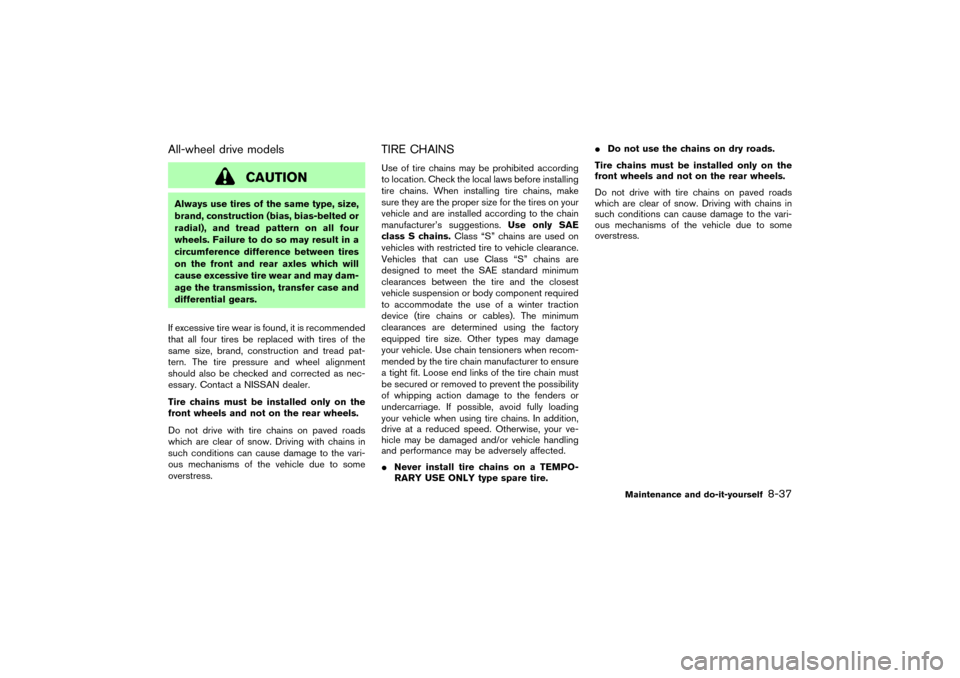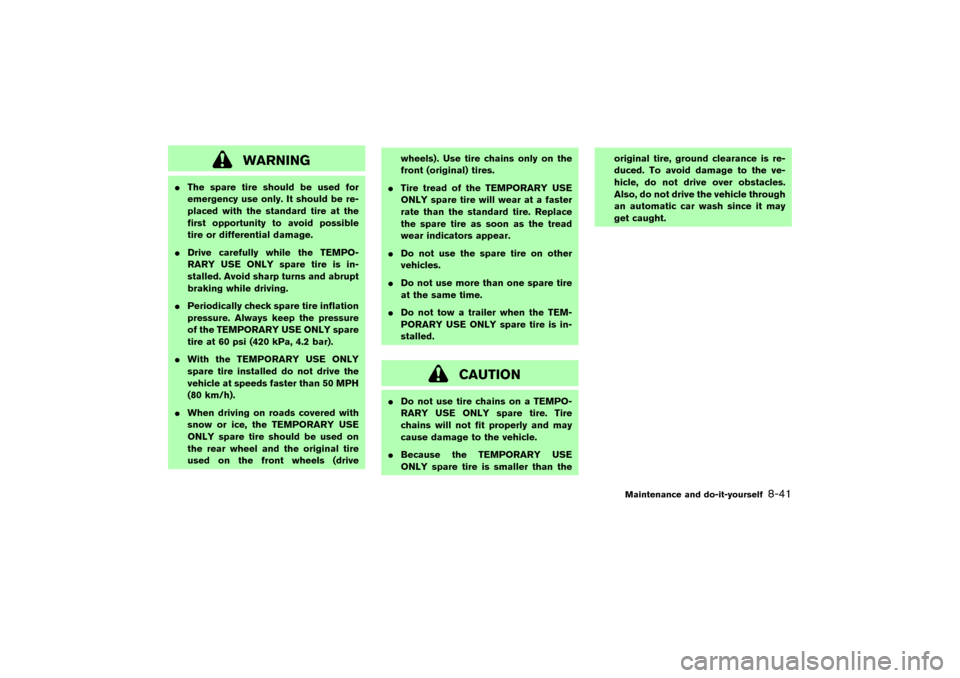Page 302 of 345

All-wheel drive models
CAUTION
Always use tires of the same type, size,
brand, construction (bias, bias-belted or
radial), and tread pattern on all four
wheels. Failure to do so may result in a
circumference difference between tires
on the front and rear axles which will
cause excessive tire wear and may dam-
age the transmission, transfer case and
differential gears.
If excessive tire wear is found, it is recommended
that all four tires be replaced with tires of the
same size, brand, construction and tread pat-
tern. The tire pressure and wheel alignment
should also be checked and corrected as nec-
essary. Contact a NISSAN dealer.
Tire chains must be installed only on the
front wheels and not on the rear wheels.
Do not drive with tire chains on paved roads
which are clear of snow. Driving with chains in
such conditions can cause damage to the vari-
ous mechanisms of the vehicle due to some
overstress.
TIRE CHAINSUse of tire chains may be prohibited according
to location. Check the local laws before installing
tire chains. When installing tire chains, make
sure they are the proper size for the tires on your
vehicle and are installed according to the chain
manufacturer’s suggestions.Use only SAE
class S chains.Class “S” chains are used on
vehicles with restricted tire to vehicle clearance.
Vehicles that can use Class “S” chains are
designed to meet the SAE standard minimum
clearances between the tire and the closest
vehicle suspension or body component required
to accommodate the use of a winter traction
device (tire chains or cables). The minimum
clearances are determined using the factory
equipped tire size. Other types may damage
your vehicle. Use chain tensioners when recom-
mended by the tire chain manufacturer to ensure
a tight fit. Loose end links of the tire chain must
be secured or removed to prevent the possibility
of whipping action damage to the fenders or
undercarriage. If possible, avoid fully loading
your vehicle when using tire chains. In addition,
drive at a reduced speed. Otherwise, your ve-
hicle may be damaged and/or vehicle handling
and performance may be adversely affected.
�Never install tire chains on a TEMPO-
RARY USE ONLY type spare tire.�Do not use the chains on dry roads.
Tire chains must be installed only on the
front wheels and not on the rear wheels.
Do not drive with tire chains on paved roads
which are clear of snow. Driving with chains in
such conditions can cause damage to the vari-
ous mechanisms of the vehicle due to some
overstress.
Maintenance and do-it-yourself
8-37
�
06.7.5/Z50-D/V5.0
�
Page 306 of 345

WARNING
�The spare tire should be used for
emergency use only. It should be re-
placed with the standard tire at the
first opportunity to avoid possible
tire or differential damage.
�Drive carefully while the TEMPO-
RARY USE ONLY spare tire is in-
stalled. Avoid sharp turns and abrupt
braking while driving.
�Periodically check spare tire inflation
pressure. Always keep the pressure
of the TEMPORARY USE ONLY spare
tire at 60 psi (420 kPa, 4.2 bar).
�With the TEMPORARY USE ONLY
spare tire installed do not drive the
vehicle at speeds faster than 50 MPH
(80 km/h).
�When driving on roads covered with
snow or ice, the TEMPORARY USE
ONLY spare tire should be used on
the rear wheel and the original tire
used on the front wheels (drivewheels). Use tire chains only on the
front (original) tires.
�Tire tread of the TEMPORARY USE
ONLY spare tire will wear at a faster
rate than the standard tire. Replace
the spare tire as soon as the tread
wear indicators appear.
�Do not use the spare tire on other
vehicles.
�Do not use more than one spare tire
at the same time.
�Do not tow a trailer when the TEM-
PORARY USE ONLY spare tire is in-
stalled.
CAUTION
�Do not use tire chains on a TEMPO-
RARY USE ONLY spare tire. Tire
chains will not fit properly and may
cause damage to the vehicle.
�Because the TEMPORARY USE
ONLY spare tire is smaller than theoriginal tire, ground clearance is re-
duced. To avoid damage to the ve-
hicle, do not drive over obstacles.
Also, do not drive the vehicle through
an automatic car wash since it may
get caught.
Maintenance and do-it-yourself
8-41
�
06.7.5/Z50-D/V5.0
�
Page 309 of 345

The following are approximate capacities. The actual refill capacities may be a little different. When refilling, follow the procedure
instructed in the “8. Maintenance and do-it-yourself” section to determine the proper refill capacity.
Capacity (Approximate)
Recommended
specifications US
measureImp
measureLiter
Fuel 21-5/8 gal 18 gal 82 Unleaded gasoline with an octane rating of at least 87 AKI (RON 91)*1
Engine oil*5
Drain and refill
With oil filter change 4-1/4 qt 3-1/2 qt 4.0
�Engine oil with API Certification Mark*2
�Viscosity SAE 5W-30
Without oil filter change 3-7/8 qt 3-1/4 qt 3.7
Cooling system
With reservoir 10-1/8 qt 8-1/2 qt 9.6
50% Genuine NISSAN Long Life Antifreeze/Coolant or equivalent
50% Demineralized or distilled water
Reservoir 7/8 qt 3/5 qt 0.8
Differential gear oil — — —Genuine NISSAN Differential Oil Hypoid Super GL-5 8W-90 or
API GL-5, Viscosity SAE 80W-90*3
CVT fluid — — — Genuine NISSAN CVT Fluid NS-2*4
Transfer oil — — — API GL-5, Viscosity SAE 80W-90
Power steering fluid (PSF)
Refill to the proper oil level according to the instructions in
the “8. Maintenance and do-it-yourself” section.Genuine NISSAN PSF or equivalent*6
Brake fluidGenuine NISSAN Super Heavy Duty Brake Fluid*7 or equivalent DOT 3
Multi-purpose grease — — — NLGI No. 2 (Lithium soap base)
Air conditioning system refrigerant — — — HFC-134a (R-134a)*8
Air conditioning system lubricants — — —NISSAN A/C System Oil
Type S or exact equivalent
Windshield washer fluidGenuine NISSAN Windshield Washer Concentrate Cleaner & Antifreeze or equivalent
*1: For additional information, see later in this paragraph for fuel recommendation.
*2: For additional information, see later in this paragraph for engine oil and oil filter recommendation.
*3: For hot climates, viscosity SAE 90 is suitable for ambient temperatures above 0°C (32°F).
*4:Use only Genuine NISSAN CVT Fluid NS-2. Using transmission fluid other than Genuine NISSAN CVT Fluid NS-2 will damage the CVT transmission,
which is not covered by the Nissan new vehicle limited warranty.
*5: For additional information, see “Engine oil” in the “8. Maintenance and do-it-yourself” section for changing engine oil.
*6: For Canada, NISSAN Automatic Transmission Fluid (ATF), DEXRON
TMIII/MERCON
TMor equivalent ATF may also be used.
*7: Available in mainland U.S.A. through a NISSAN dealer.
*8: For additional information, see “Vehicle identification” in this section for air conditioner specification label.
CAPACITIES AND
RECOMMENDED
FUEL/LUBRICANTS9-2
Technical and consumer information
�
06.7.5/Z50-D/V5.0
�